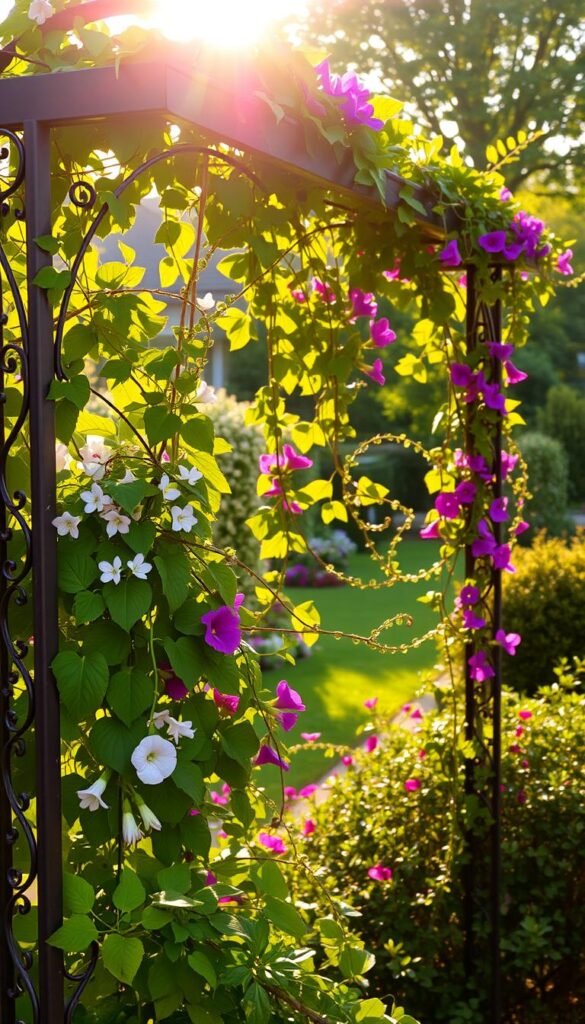Welcome to your go-to resource for creating eye-catching vertical displays that boost plant health while enhancing your yard’s charm. Whether you’re working with sprawling landscapes or cozy patios, these structures offer practical support for climbing plants and instant character for bland spaces.
Vertical frameworks help maximize limited areas by guiding greenery upward. They transform plain walls or empty corners into living art displays, blending function with natural beauty. You’ll find solutions for common issues like privacy needs or awkward empty spots along fences.
Discover how simple materials like reclaimed wood or metal rods can become stunning plant supporters. Projects range from beginner-friendly builds to advanced installations worthy of magazine spreads. Each design serves as both plant trainer and artistic statement, proving practicality doesn’t sacrifice style.
Learn to select shapes and materials that complement your existing decor while providing sturdy growth paths for vines. These adaptable setups work equally well in urban balconies and suburban backyards, offering fresh ways to reimagine your green spaces.
Welcome to Your Garden Trellis Inspiration
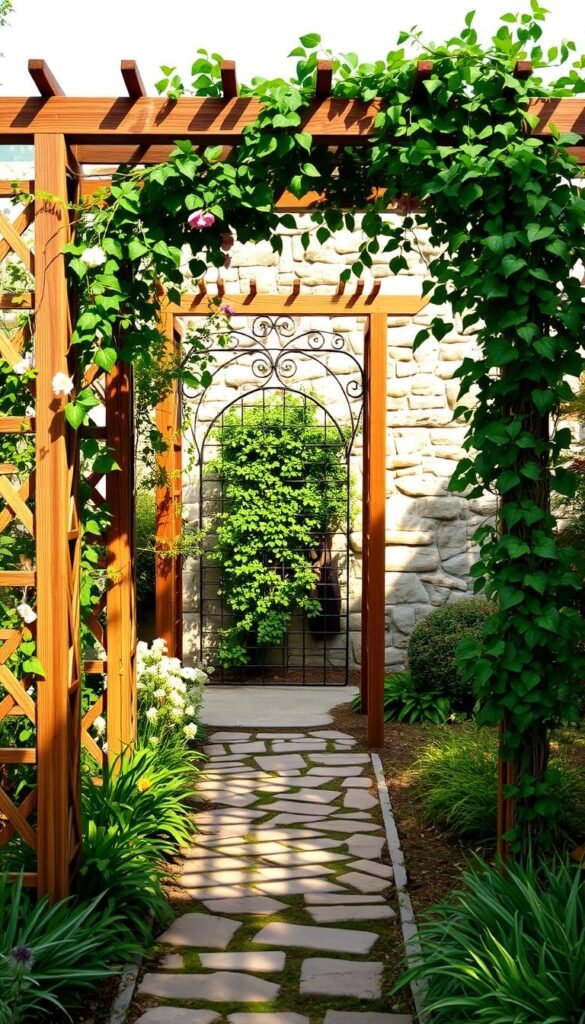
Imagine stepping into a space where living architecture meets natural beauty. Vertical structures do more than hold up stems – they reimagine how you interact with your surroundings. These frameworks turn bland walls into cascading floral displays and transform empty corners into thriving green pockets.
From dainty morning glories to heavy squash vines, the right structure adapts to your needs. A well-placed design creates depth in compact areas, making balconies feel like secret gardens. Even winter reveals hidden charm when bare branches trace intricate patterns against your walls.
| Structure Type | Best For | Material Options |
|---|---|---|
| Flat Panel | Wall coverage | Metal, cedar, bamboo |
| Arched | Entryway accents | Wrought iron, PVC |
| Obelisk | Focal points | Copper, salvaged wood |
| Lattice | Privacy screens | Redwood, vinyl |
Urban dwellers often find vertical solutions double their growing space. One gardener transformed a fire escape using foldable metal grids, harvesting tomatoes eight stories up. As seasons shift, your creation evolves – spring buds become summer shade, then autumn’s golden curtain.
“A trellis isn’t just support – it’s a canvas where nature paints her masterpiece.”
Your outdoor area gains new purpose when you think upward. Sturdy designs handle vigorous climbers like wisteria, while delicate patterns showcase sweet peas. Every choice reflects your style, whether modern minimalism or cottage charm.
Exploring Different Trellis Materials
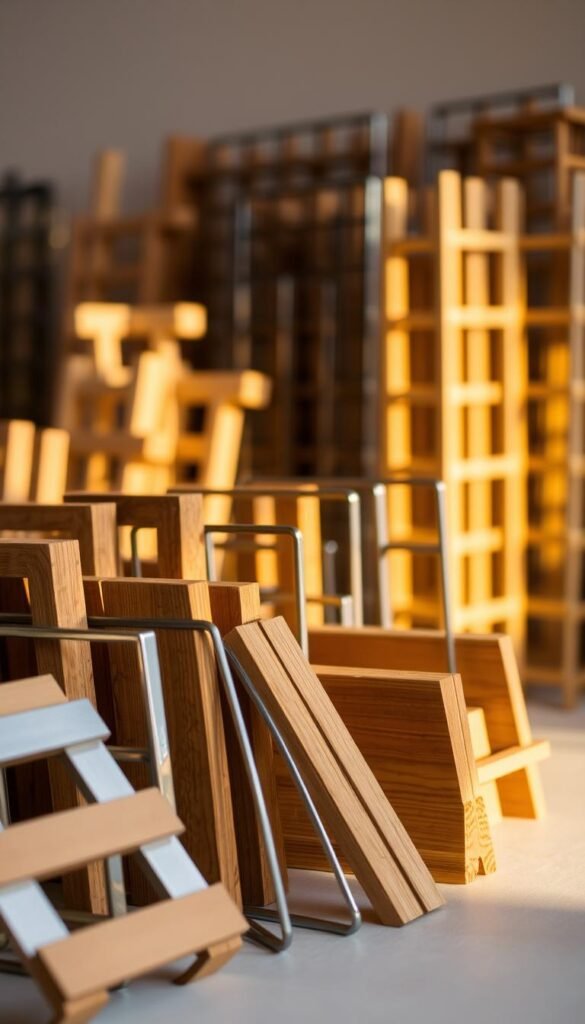
The foundation of any great vertical garden starts with choosing the right building blocks. Your material selection impacts durability, aesthetics, and plant compatibility. Let’s break down popular options to help you make informed decisions.
Natural Warmth vs Industrial Strength
Wooden structures bring earthy charm to cottage-style spaces. Cedar and redwood resist rot naturally, while pressure-treated pine offers budget-friendly longevity. They blend with flowering vines like clematis but require seasonal maintenance.
Metal frameworks shine in modern settings. Stainless steel grids handle heavy climbers like grapes effortlessly. Galvanized wire lattices disappear behind delicate sweet peas, letting blooms take center stage. Unlike wood, they won’t warp during rainy seasons.
Green Solutions with Character
Transform discarded items into plant supporters with personality:
- Twist old bicycle wheels into circular frames for beans
- Repurpose wooden pallets as instant climbing walls
- Use copper pipes from renovation projects for sleek arches
These DIY vertical solutions save money while reducing landfill waste. One creative gardener turned vintage bed springs into a sprawling cucumber tower!
Your climate plays a key role. Humid areas benefit from rust-resistant metals, while dry regions can utilize untreated branches. Mix materials for visual contrast – imagine a weathered oak frame wrapped in slender iron rods.
Creative Trellis Designs for Climbing Plants
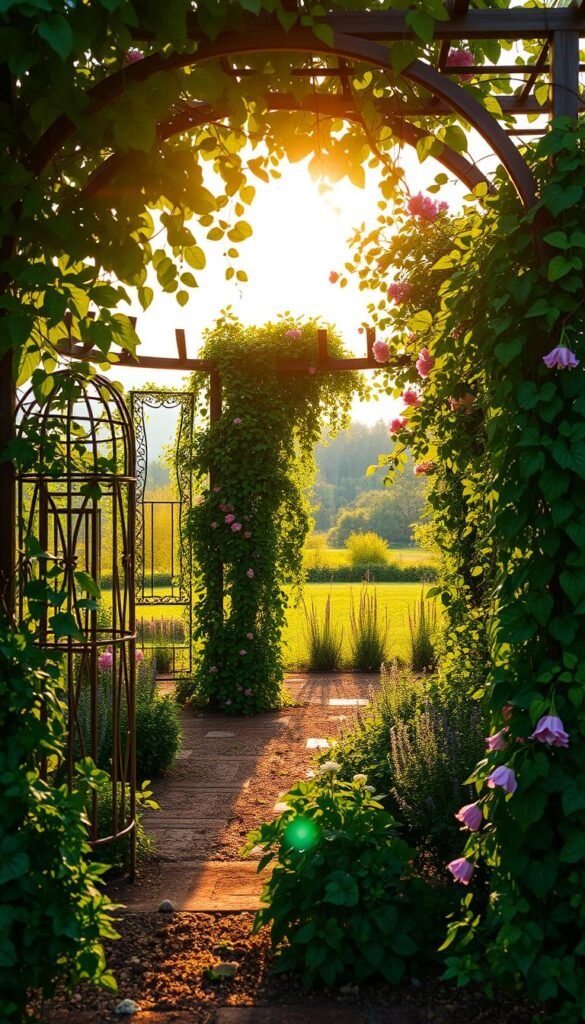
Transform your vertical spaces into thriving ecosystems with smart structural choices. The right framework turns functional supports into artistic statements while giving climbing plants exactly what they need to flourish. Let’s explore how to match different growth habits with clever designs.
Tips for Supporting Flowering Vines
Delicate flowering vines like sweet peas thrive on fine-textured surfaces. Install mesh panels or thin wooden slats spaced 2-4 inches apart. These create perfect ladders for tendrils to grasp without overwhelming delicate stems. For heavy bloomers like climbing roses, use sturdy metal grids anchored deep into the ground.
Incorporating Vegetable Vines
Edible climbers demand robust solutions. A V-shaped panel trellis offers expanding space as squash or cucumbers grow. Wrap obelisk frames with chicken wire for watermelons – the flat top doubles as a platform for trailing herbs in pots. Portable designs let you rotate crops without rebuilding structures each season.
| Design | Best Plants | Key Feature |
|---|---|---|
| Obelisk + Chicken Wire | Melons, Gourds | Adjustable horizontal supports |
| V-Shaped Panel | Cucumbers, Beans | Gradual width expansion |
| Foldable Grid | Peas, Nasturtiums | Space-saving storage |
Looking for more inspiration? Discover versatile setups that blend practicality with visual appeal. Remember: lightweight annuals need less support than fruit-bearing perennials. Match your structure’s strength to your plant’s ambitions!
Panel Trellis Styles for Versatile Gardens
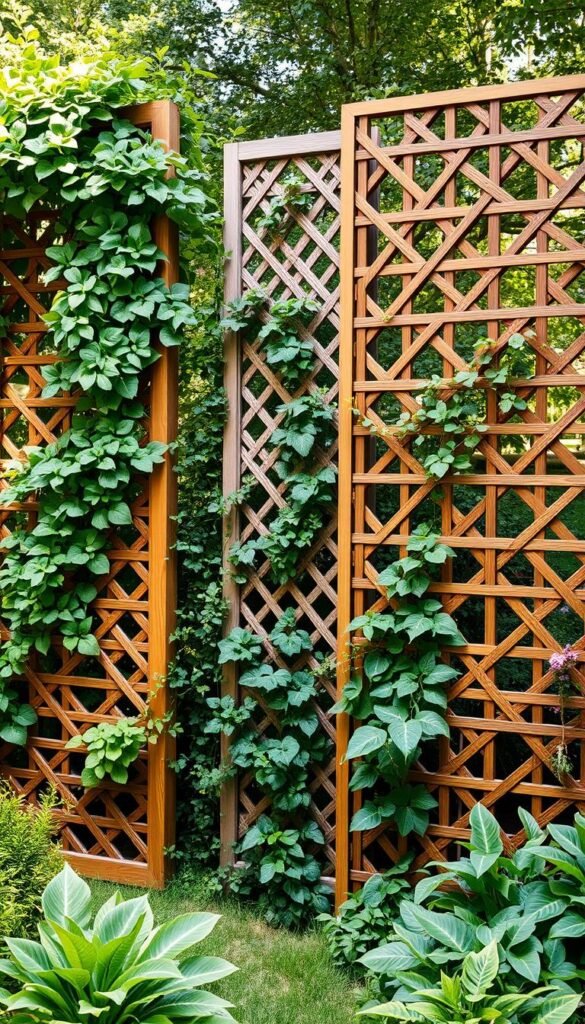
Maximize your growing potential with panel systems that blend planting space with vertical support. These adaptable frameworks let you grow upward and outward simultaneously, perfect for spaces where every square foot counts. A well-designed setup becomes both functional backbone and design focal point.
Raised Bed with Pergola Elements
Combine elevated planters with overhead structures for double-duty growing. A tiered bed with lattice backing lets beans climb while flowers bloom below. The tall design reduces bending – ideal for those preferring stand-up gardening. Central pergola-style panels create shaded areas for delicate greens while supporting vigorous climbers above.
Consider these popular configurations:
| Panel Type | Best Use | Key Feature |
|---|---|---|
| Tiered Lattice | Mixed planting | Multi-level support |
| Tall Planter | Accessible gardening | Waist-high design |
| Pergola Hybrid | Shade lovers | Overhead coverage |
Modular panels let you rearrange layouts as crops rotate. One urban grower transformed their patio using versatile setups that hide AC units while producing tomatoes. The secret? Matching panel strength to plant needs – lightweight mesh for peas, reinforced metal for melons.
Overhead elements boost yield potential. Cucumbers cascade from pergola crossbars, shading lettuce beneath. This layered approach turns small plots into productive ecosystems. Your structure evolves with the seasons, offering endless creative possibilities.
Obelisk Trellis Inspirations
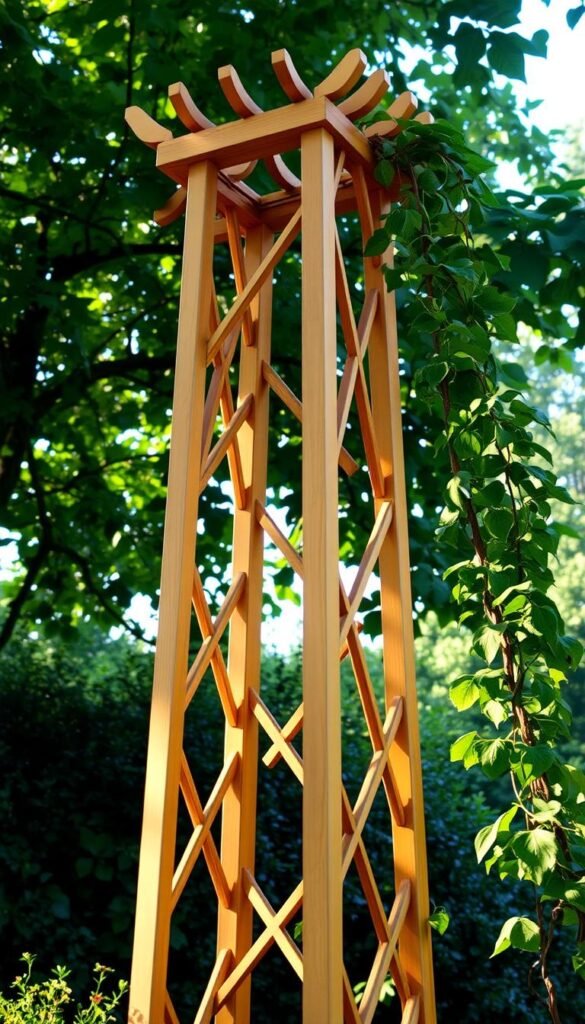
Elevate your outdoor space with striking vertical elements that combine form and function. Obelisk structures offer year-round appeal, guiding plants skyward while creating eye-catching focal points. Their geometric shapes bring architectural interest even when vines go dormant in colder months.
DIY Branches-and-Twine Techniques
Create charming rustic obelisks using fallen poplar saplings and jute twine. Cut four 6-foot branches for the base, then lash shorter crosspieces at 12-inch intervals. This design works perfectly for lightweight climbers like morning glories – their tendrils cling easily to the textured surface.
For added stability:
- Anchor legs 12″ deep in soil
- Use weather-resistant hemp cord
- Add diagonal braces for windy areas
Using Old Grapevine Branches
Transform pruned grapevines into natural living sculptures. Fresh cuttings bend easily – weave them into spiral patterns or interlocking diamonds. Once dried, these durable frameworks support sweet peas or miniature roses. One clever twist: leave protruding twigs as built-in plant hooks.
Flat-top variations expand your design options. Attach a chicken wire platform to display trailing succulents or herbs in pots. These multi-level installations maximize vertical space while creating visual depth. As one gardener noted:
“My modified obelisk became a rotating art gallery for seasonal plants.”
Elegant Arch and Pergola Trellises
Transform your garden’s entryway into a blooming masterpiece with arches and pergolas that marry elegance with purpose. These grand frameworks turn functional plant support into breathtaking landscape features, creating natural invitations to explore your outdoor sanctuary.
Cottage Arbor Trellis Ideas
A curved arbor draped with climbing roses becomes an irresistible welcome mat. Position it over garden gates or pathways to frame views with fragrant blooms. Choose varieties like ‘New Dawn’ or ‘Zephirine Drouhin’ for continuous color from spring through frost.
Stunning Pergola Statements
Substantial overhead structures like pergolas handle vigorous growers while shading seating areas. Train clematis along vertical posts and let grapevines weave through crossbeams. For stability, set support posts 30% deeper than their above-ground height – crucial for windy regions.
| Feature | Arch | Pergola |
|---|---|---|
| Best Plants | Roses, wisteria | Grapes, kiwi |
| Installation Depth | 18-24″ | 24-36″ |
| Key Benefit | Focal point | Shade + support |
One gardener shared their success:
“Our arched entrance became the neighborhood landmark when ‘Eden’ roses covered it completely in two seasons.”
Consider growth patterns when planning. Passionflower vines might overwhelm delicate arches but thrive on sturdy pergola frameworks. Match your plant’s ambition to your structure‘s strength for lasting beauty.
Innovative Trellis Ideas for Small Spaces
Unlock new possibilities in compact areas with structures that evolve alongside your plants. Vertical gardening thrives when you break free from permanent installations, especially in urban settings or rental properties. These adaptable systems let you chase sunlight and rearrange layouts as needs change.
Flexible Frameworks for Dynamic Spaces
Container-based systems revolutionize balcony gardening. A simple wooden grid secured to a planter lets cucumbers climb while remaining mobile. When frost threatens, roll your setup indoors using casters attached to the base. One urban grower reported:
“My rolling tower produced three zucchini harvests after moving between my sunny fire escape and living room.”
Consider these space-smart options:
| Type | Best Use | Mobility Feature |
|---|---|---|
| Container Grid | Balcony veggies | Detachable panels |
| Folding Frame | Seasonal flowers | Hinge joints |
| Rolling Tower | Patio fruits | Locking wheels |
Modular designs serve multiple roles. A folding screen trellis shades afternoon sun while supporting passionflower vines. Come evening, it transforms into a privacy partition for outdoor dinners. For creative outdoor arrangements, try repurposing ladder shelves as tiered plant supporters.
Lightweight materials make relocation effortless. Aluminum poles with nylon mesh weigh less than 5 pounds yet handle pole beans effortlessly. These smart solutions prove limited square footage can’t constrain green ambitions when you think vertically and stay mobile.
Functional Wall-Mounted and Privacy Trellises
Turn overlooked spaces into lush focal points with structures that work smarter, not harder. Wall-mounted designs blend plant support with artistic flair, while freestanding screens create intimate outdoor rooms without blocking sunlight.
Creating a Living Privacy Screen
Mount a white-painted grid 6 inches from your exterior wall to let clematis or climbing roses thrive. This air gap prevents moisture buildup while giving tendrils space to twine. The crisp backdrop makes floral colors pop like nature’s own gallery display.
For seating areas needing subtle separation, try twin lattice panels flanking your patio. These living walls filter sunlight while letting breezes through – perfect for enjoying morning coffee without feeling exposed. Urban balcony setups especially benefit from this approach, as shown in these space-saving solutions.
| Type | Best Plants | Installation Tip |
|---|---|---|
| Wall-Mounted | Morning glories | Use rust-proof brackets |
| Freestanding Screen | Honeysuckle | Anchor with gravel base |
| Panel Divider | Jasmine | Space panels 3ft apart |
Unlike solid fences, these green barriers evolve through seasons. Spring brings fresh growth, summer offers shade, and autumn reveals intricate branch patterns. One gardener shared:
“Our ivy screen became a bird sanctuary – we get daily shows from chickadees and wrens.”
Maintenance stays simple. Annual pruning keeps plants tidy, while removable panels make repainting easy. Your space stays private yet connected to nature’s rhythm.
Garden Trellis Ideas to Support Vines and Add Visual Interest
Your outdoor space becomes a living gallery when you blend functional frameworks with artistic flair. Vertical structures do more than prop up stems—they craft dynamic scenes where foliage and flowers take center stage. Practical support meets creative expression in designs that elevate both plant health and curb appeal.
Mix materials and shapes to create depth. A weathered metal arch paired with bamboo lattices adds texture contrast, while curved wire forms soften angular fences. These combinations guide growth patterns and create focal points that draw the eye upward.
Seasonal changes reveal hidden benefits. Bare winter branches trace intricate shadows, while summer blooms cascade like living curtains. One gardener noted:
“My climbing hydrangea transformed a plain wall into a year-round spectacle—lush in June, fiery red in October.”
Choose structures that align with your vision. Rustic branch arrangements complement cottage-style spaces, while powder-coated steel grids suit modern aesthetics. Prioritize durability for heavy growers like grapes, but don’t shy from delicate patterns for sweet peas or nasturtiums.
Layered installations maximize impact. Place shorter obelisks near seating areas and taller screens along property lines. This approach creates intimate nooks while maintaining open sightlines. Your design evolves as plants mature, proving beauty and utility grow hand in hand.
Eco-Friendly and Upcycled Trellis Concepts
Breathing new life into forgotten objects creates eco-conscious vertical gardens bursting with personality. These sustainable solutions turn salvaged materials into functional art, proving style doesn’t require new resources. You’ll discover beauty in weathered textures and stories hidden within repurposed pieces.
Windows, Ladders & Fence Revival
An old window frame becomes a striking backdrop for star jasmine when you remove its glass panes. The geometric dividers naturally guide vines while adding rustic charm. Lean a vintage ladder against your shed for ivy to climb – its rungs create perfect footholds for tendrils.
Salvaged fence sections offer instant vertical structure. Position one against your home’s exterior for quick coverage. The weathered wood blends seamlessly with climbing plants like Virginia creeper, developing a patina that improves with age.
Scour flea markets for unique materials with built-in character. Wrought iron gates become ornate frames for roses. Antique bed springs transform into spiral supports for beans. Each piece carries history while reducing landfill waste – a win for your space and the planet.

